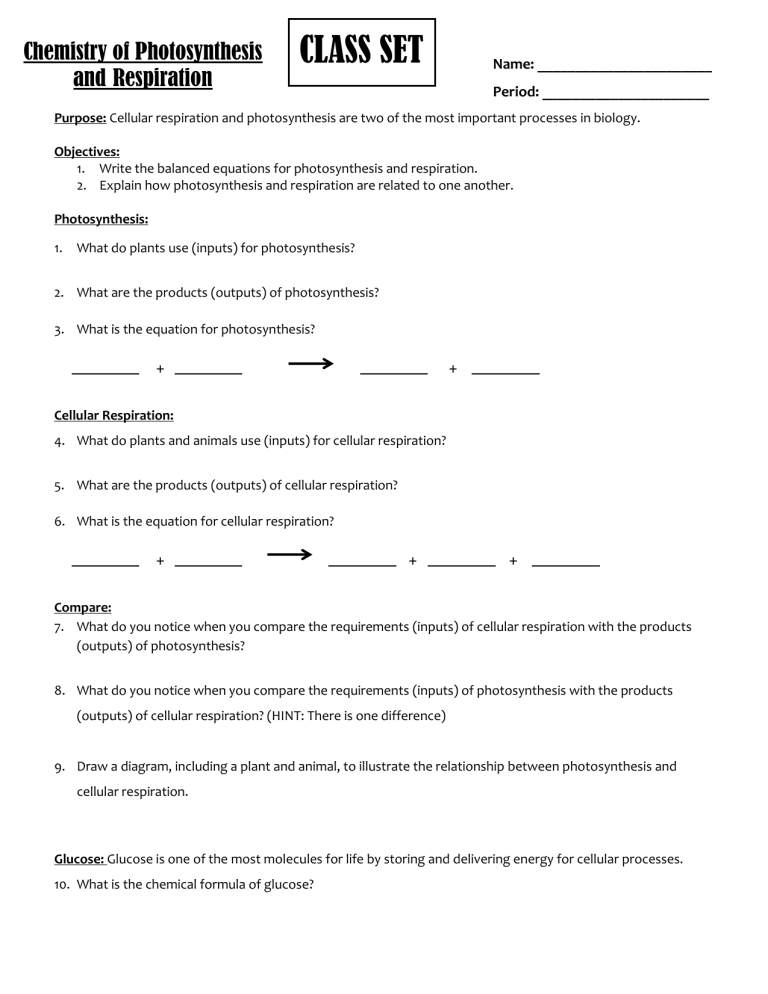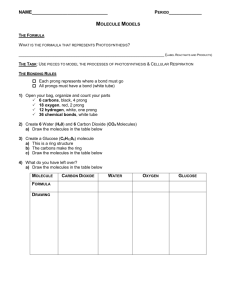Chemistry of PhotoResp

Chemistry of Photosynthesis and Respiration
CLASS SET
Name: _______________________
Period: ______________________
Purpose: Cellular respiration and photosynthesis are two of the most important processes in biology.
Objectives:
1.
Write the balanced equations for photosynthesis and respiration.
2.
Explain how photosynthesis and respiration are related to one another.
Photosynthesis:
1.
What do plants use (inputs) for photosynthesis?
2.
What are the products (outputs) of photosynthesis?
3.
What is the equation for photosynthesis?
+
Cellular Respiration:
4.
What do plants and animals use (inputs) for cellular respiration?
+
5.
What are the products (outputs) of cellular respiration?
6.
What is the equation for cellular respiration?
+ + +
Compare:
7.
What do you notice when you compare the requirements (inputs) of cellular respiration with the products
(outputs) of photosynthesis?
8.
What do you notice when you compare the requirements (inputs) of photosynthesis with the products
(outputs) of cellular respiration? (HINT: There is one difference)
9.
Draw a diagram, including a plant and animal, to illustrate the relationship between photosynthesis and cellular respiration.
Glucose: Glucose is one of the most molecules for life by storing and delivering energy for cellular processes.
10.
What is the chemical formula of glucose?
11.
Now you will build a glucose molecule. a.
What color is each of the following? i.
Carbon is ii.
Oxygen is iii.
Hydrogen is iv.
A chemical bond is b.
Use the structural formula to build a glucose model. i.
HINT: Begin with the basic ring backbone of 5 C and 1 O, then add the rest of the C, O and H. c.
How many atoms of each element are there? i.
Carbon: ii.
Oxygen: iii.
Hydrogen:
d.
SAVE THIS GLUCOSE MOLECULE
Chemistry:
12.
Make 6 O2 molecules, save them for the next step.
13.
Rewrite the equation for photosynthesis:
+
14.
Rewrite the equation for cellular respiration:
+
+
+ +
15.
The glucose and O2 models that you have built are requirements (inputs) for what process?
16.
After glucose has traveled through your bloodstream and entered your cells what ORGANELLE processes it?
17.
What is the first thing that happens to glucose when it enters the mitochondria?
18.
What are proteins that can break molecules (like glucose) apart called? (HINT: examples of this end in –ase)
19.
Now break apart glucose and oxygen and ONLY THOSE ATOMS to make as many CO2 and H2O molecules as possible. When the bonds of glucose are broken apart energy is released in the form of heat, or kinetic energy in muscles. a.
How many molecules of GLUCOSE did you start with? b.
How many molecules of O2 did you start with? c.
How many molecules of CO2 did you end up with? d.
How many molecules of H2O did you end up with?
20.
Now write the BALANCED equation for cellular respiration using the number of molecules as COEFFICIENTS:
+ + +
21.
What is the ENERGY MOLECULE that provides the energy for the cellular processes (and life) for most organisms?
22.
Consider the CO2 and H2O molecules that you have made. In nature, what process uses these molecules?
23.
What has to happen to CO2 and H2O in order to make the products of this process?
24.
In what organelle does this process take place?
25.
What abiotic factor is used as an energy source by this process?
26.
Break apart CO2 and H2O and use the atoms to make glucose and O2. Solar energy is stored in the bonds of glucose. a.
How many molecules of CO2 did you start with? b.
How many molecules of H2O did you start with? c.
How many molecules of GLUCOSE did you end up with? d.
How many molecules of O2 did you end up with?
27.
Now write a BALANCED equation for photosynthesis using the number of molecules as COEFFICIENTS:
Conclusions:
+ +
28.
What is the purpose of photosynthesis for plants?
29.
What purpose does photosynthesis serve for animals?
30.
What is the purpose of cellular respiration for animals?
31.
What purpose does cellular respiration serve for plants?







